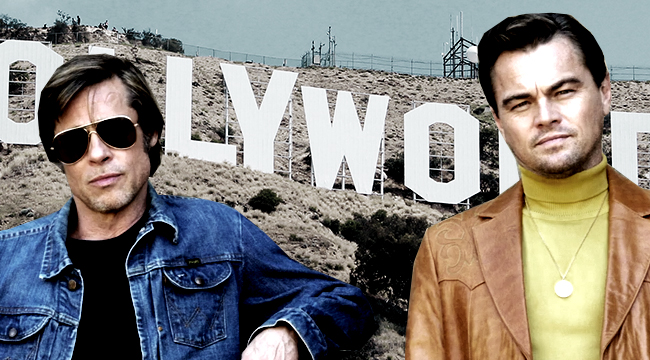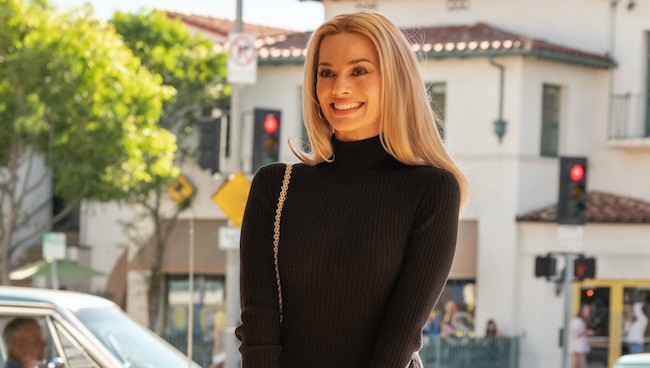
Early in Quentin Tarantino’s Once Upon a Time in… Hollywood, we see a flashback of Leonardo DiCaprio’s Rick Dalton, in better times, career-wise, starring in a World War II movie, using a flamethrower to burn a bunch of Nazis. It’s hard not to think of one of Tarantino’s previous films, Inglourious Basterds, a revisionist’s history of World War II where we cheered along as our heroes killed Hitler with a machine gun and saved the world from the scourge of Nazism. Once Upon a Time in… Hollywood plays around with similar themes, a “what if?” world that, in its moments, feels good for a second, and then it makes us a little sad. I guess that’s the point. Ten years ago, when Inglourious Basterds came out, we all kind of thought of “fighting Nazis” as a thing of the past. But watching Rick Dalton fight Nazis takes on a renewed meaning and significance today, what with the sudden rise of white nationalism in America and in Europe.
I’ve heard people say they feel Once Upon a Time in… Hollywood displays a kinder, gentler, less angry Tarantino. I disagree. I think he’s plenty angry.
Is there a way to use the word “meandering” as a positive? Because Once Upon a Time in… Hollywood is a *meandering* movie that doesn’t feature much of a traditional plot. I swear that’s meant in the most positive way possible.It’s like when you’re walking down the street, on a nice summer day, with nowhere to be, just looking around, enjoying your day. You are meandering, but it’s also enjoyable. You’re just taking it all in. This is a good way to describe Once Upon a Time in… Hollywood. With a running time of 160 minutes, Tarantino has nowhere to be anytime soon.
We spend a good chunk of the movie-watching a shirtless Brad Pitt’s former stuntman, now basically a jack-of-all-trades personal assistant, Cliff Booth, fix a rooftop television antenna. Later, we watch Pitt’s Booth and DiCaprio’s Dalton watch an episode of FBI. (This might be my favorite individual scene of the whole movie. DiCaprio’s Rick Dalton has a guest-starring role and Pitt’s Cliff Booth just sits there giving commentary. When Rick Dalton pops up in the episode, Pitt says, in a monotone voice, “Here comes trouble.”)
What Tarantino does in Once Upon a Time in… Hollywood is threefold. First, he’s there to set the mood of what Hollywood was like in 1969, from the perspective of two kind-of-washed-up has-beens. He’s also there to get in literally every reference that he can from this era. It’s so over the top it eventually becomes endearing. I mean, Norman Fell even gets a cameo. Third, he slowly sprinkles in sinister beats from the Manson family. Which, if you’re living in Hollywood around that time, I suspect that’s what it was probably like before the murders happen, just strange stories about all the weirdo hippies living out at the Spahn Ranch — a ranch owned by George Spahn (played by Bruce Dern) that was occasionally used for film shoots — who sometimes integrated themselves with famous people. So I’m sure someone at some party uttered the question, “Wait, Dennis Wilson from The Beach Boys is hanging out with them?,” in disbelief. So by the time we get to Charles Manson in this movie, Tarantino has done a pretty great job of setting up just how odd all of this is.
A lot will be written about Once Upon a Time in… Hollywood being Tarantino’s love letter to Hollywood. I mean, yeah, sure, there’s that. But I think it’s more Tarantino’s excuse to shoot a confetti cannon of every last reference he loves into the zeitgeist before he hits that magical 10th and last movie he keeps talking about. (This is assuming everyone is on board with Kill Bill being one movie.) And that’s great! I enjoy Tarantino’s cultural references! But these are all fun bells and whistles surrounding what this movie really does, which is to serve as a love letter to the legacy of Sharon Tate, played lovingly here by Margot Robbie.

I’m glad this movie exists if, for nothing else, to introduce new generations to Sharon Tate. And, frankly, I include myself in this. What Once Upon a Time in… Hollywood does best – and most importantly – is frame Sharon Tate as a human being we should get to know. For far too long she’s been known, mostly, terribly, as Roman Polanski’s wife who was the victim of an awful, gruesome murder. It’s a terrible narrative. Without getting into too many details that become spoilerish, Tarantino is not here to bring Tate’s murder into the spotlight. Or Polanski (he’s barely in it). Tarantino is here to present Tate as a human being with a world of potential. There’s an extended scene of Robbie as Tate, going into a movie theater to watch her new film, The Wrecking Crew, with an audience. Robbie’s Tate sits there, soaking up every laugh she gets from the crowd, as we see the real Sharon Tate on screen. It’s an extremely effective juxtaposition.
There were some complaints about Margot Robbie’s limited screen time in Once Upon a Time in… Hollywood. This was brought up at the press conference back in May at Cannes. And yes, her screen time is limited, but her presence is always felt. The best way to present Tate as a human being was to keep her out of the plot and just, here and there, show her doing things any other human beings in her position might be doing at any given time. She is the ghost who haunts this movie.
It’s obvious Tarantino isn’t just angry about what happened to Sharon Tate on her last night on this earth, but he’s also angry about what happened to her legacy. Once Upon a Time in… Hollywood exists to try to change that legacy. And Tarantino succeeds.
‘Once Upon A Time In Hollywood’ opens July 26th. You can contact Mike Ryan directly on Twitter.






